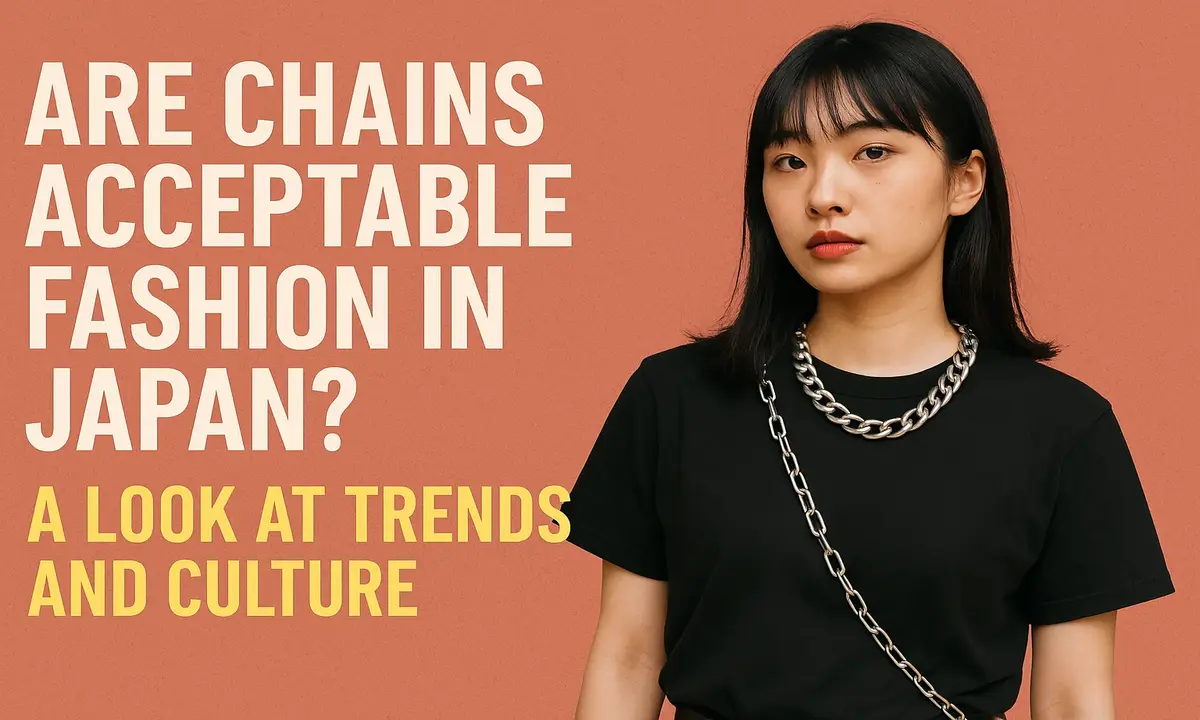Fashion in Japan is unique and ever-evolving. It combines traditional influences with modern innovation, creating a dynamic and diverse scene. When it comes to accessories, chains have always played a significant role in fashion trends globally.
But are chains, in various forms, acceptable in Japan’s fashion landscape? In this article, we will explore the cultural nuances surrounding chains in Japanese fashion.
Whether you’re considering chains for your style or are curious about Japan’s fashion trends, this guide will offer valuable insights. Lets dive in!
Understanding Japan’s Fashion Culture
Japan’s fashion culture is a blend of tradition and modernity. The country has a reputation for setting global fashion trends, especially in cities like Tokyo, where street style thrives in districts such as Harajuku.
Japanese fashion isn’t just about what’s trendy but also about personal expression. While the nation is known for minimalism and clean, structured designs, it has also embraced bold and unconventional looks.
Chains, as accessories, have a long history. In Western fashion, they’re often seen in hip-hop culture, punk rock, and luxury high fashion. But what about Japan? Do chains have the same influence? Let’s take a look at how they are perceived in Japan’s fashion world.
Read More: Fashionisk.com: Your Ultimate Online Fashion Hub
Chains in Street Style
Japanese street fashion is famous for its eclectic and boundary-pushing nature. In the fashion districts of Tokyo, chains can often be seen adorning the outfits of young people, particularly in areas like Harajuku. Here, chains are used to create a bold statement or add flair to casual wear.
Types of Chains Seen in Street Fashion
- Chunky Chains: Large, bold chains are often worn in street style, especially by those in the punk or alternative subcultures. They are paired with oversized clothing or layered on top of T-shirts and hoodies to create a striking look.
- Chain Belts: A popular accessory for both men and women, chain belts add edge to any outfit. They’re often worn with casual or oversized outfits, like baggy pants or skirts.
- Chain Necklaces: Bold, thick chain necklaces are favored by those in the fashion-forward crowd. They’re often paired with simple outfits to make the chain the focal point of the look.
In street fashion, chains are a way for individuals to showcase their personality and make a fashion statement. It’s not just about luxury or bling; it’s a form of self-expression and creativity.
Chains in High Fashion
While street style is often the first place to spot chains, they have also made their way into high fashion in Japan. Designers in Japan’s fashion industry, like Issey Miyake, Rei Kawakubo, and Yohji Yamamoto, are known for their avant-garde approach to design.
These designers occasionally incorporate chains into their collections, using them to enhance the overall aesthetic of their runway shows.
How Chains Are Used in High Fashion
- Subtle Elegance: In high fashion, chains tend to be more refined and understated. Gold or silver chains are sometimes used in minimalist designs to add texture or to create a contrast between soft and hard elements in the clothing.
- Statement Pieces: On the runway, chains are sometimes used as a bold statement piece. A single statement necklace or dramatic belt can make an outfit stand out and take it from simple to striking.
In Japan’s luxury fashion scene, chains are often seen as a sign of opulence and status.
However, unlike in Western culture, where chains are sometimes associated with loud luxury, Japanese high fashion tends to incorporate them in a more sophisticated and minimalist manner.
Traditional Japanese Fashion and Chains
At first glance, chains may seem out of place in traditional Japanese fashion. However, there are instances where they have been used in more subtle ways in historical garments.
For example, the “obi,” which is the wide belt worn with a kimono, often features intricate metalwork, some of which includes chain-like designs.
Though not as prominent as in modern street fashion, these subtle touches show that chains have a place in traditional attire, albeit in a more refined and ceremonial capacity.
Also Visit: Guccimania24: The Fashion and Music Phenomenon of the Year
How Chains Are Perceived by Different Generations
In Japan, the perception of chains varies across different age groups. Younger generations, especially those involved in subcultures like punk or street fashion, are more likely to embrace bold chain accessories. For them, chains are a form of self-expression and a way to stand out from the crowd.
On the other hand, older generations may view chains with more caution. While they appreciate the aesthetic value of jewelry, they might prefer more subtle and traditional accessories.
The use of chains in fashion by older Japanese individuals is often restricted to high-end, understated jewelry rather than bold, statement pieces.
The Global Influence on Japanese Fashion
Japan’s fashion scene is influenced not only by its own rich cultural history but also by global trends. Western styles, including the use of chains, have impacted Japanese fashion in significant ways.
From hip-hop culture to punk rock, the global rise of these movements has influenced how chains are used in Japanese street style.
The Role of Chains in Global Trends
- Hip-Hop Culture: Chains became a staple in hip-hop fashion, especially in the U.S., and this influence spread to Japan. In the 1990s and early 2000s, hip-hop-inspired fashion, including chains, was adopted by Japanese youth. Today, this influence remains visible in street style.
- Punk and Rock: The punk movement, known for its rebellious attitude and bold fashion, also brought chains into the spotlight. In Japan, the punk scene adopted chains as part of its distinctive look, often using them to accessorize leather jackets, studded belts, and ripped jeans.
The Role of Chains in Luxury Brands in Japan
Many luxury brands are a prominent part of Japan’s fashion scene. Brands like Louis Vuitton, Chanel, and Gucci often incorporate chains in their accessories, like handbags, jewelry, and clothing.
The use of chains in these luxury items speaks to the idea of combining tradition with modernity. While some chains may be flashy and bold, others are used more subtly, fitting into the minimalist Japanese aesthetic.
Chains in Fashion Influencers and Celebrities
In today’s world of social media and influencers, fashion icons in Japan are frequently seen sporting chains in their outfits. Japanese celebrities, especially those in the music industry, frequently use chains as a symbol of status or to give their outfits a unique touch.
These figures are highly influential, and their fashion choices often dictate trends across the nation.
Conclusion: Are Chains Acceptable in Japanese Fashion?
Chains are not only acceptable in Japan’s fashion scene but are also embraced in various forms, from bold street style to more refined high fashion.
Whether used as a statement piece in street fashion or incorporated into the minimalist elegance of high-end designs, chains have found their place in Japan’s diverse fashion landscape.
The cultural acceptance of chains varies depending on age, subculture, and personal style, but they are undoubtedly a fixture in Japan’s modern fashion world.
FAQ
What are the most common ways chains are used in Japan’s street fashion?
In Japan’s street fashion, chains are used as statement pieces. Chunky chains, chain belts, and chain necklaces are all popular choices, especially among younger generations in areas like Harajuku.
Are chains considered formal accessories in Japan?
Chains are not typically considered formal accessories in Japan, except in high fashion or luxury items. In traditional attire like kimono, chains are not commonly seen but subtle metalwork may be used.
How do older generations in Japan view chains in fashion?
Older generations in Japan tend to prefer more subtle and traditional accessories. They may not embrace bold, chunky chains as much as younger people, who use them for self-expression in street fashion.
Can chains be worn in traditional Japanese attire?
Chains are not typically part of traditional Japanese attire. However, some subtle chain-like elements, such as metalwork on the obi belt, can be seen in historical garments, adding a slight nod to chains in traditional fashion.
What influence does global fashion have on chains in Japan?
Global trends, especially from hip-hop and punk culture, have significantly influenced how chains are used in Japan’s street fashion. Western luxury brands also incorporate chains in their designs, which has impacted Japan’s fashion industry.












